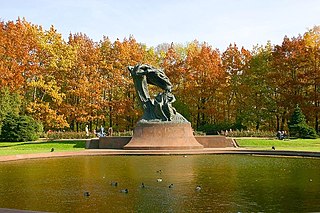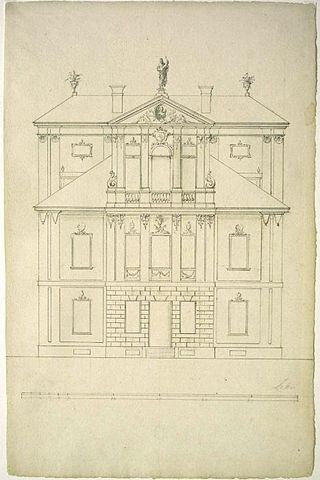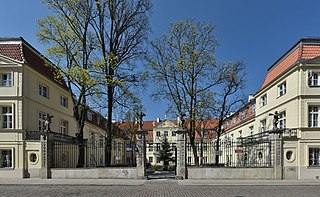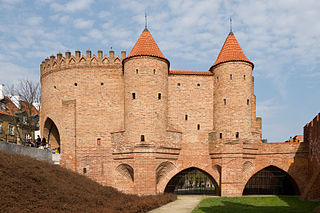
Wilanów is a district of the city of Warsaw, Poland. It is home to historic Wilanów Palace, the "Polish Versailles," and second home to various Polish kings. Wilanów is home to many villas and, despite being relatively far away from the city center, the district ranks among the most expensive in Warsaw.

Łazienki Park or Royal Baths Park is the largest park in Warsaw, Poland, occupying 76 hectares of the city center.
The Polish Baroque lasted from the early 17th to the mid-18th century. As with Baroque style elsewhere in Europe, Poland's Baroque emphasized the richness and triumphant power of contemporary art forms. In contrast to the previous, Renaissance style which sought to depict the beauty and harmony of nature, Baroque artists strove to create their own vision of the world. The result was manifold, regarded by some critics as grand and dramatic, but sometimes also chaotic and disharmonious and tinged with affectation and religious exaltation, thus reflecting the turbulent times of the 17th-century Europe.

The Saxon Garden is a 15.5–hectare public garden in central (Śródmieście) Warsaw, Poland, facing Piłsudski Square. It is the oldest public park in the city. Founded in the late 17th century, it was opened to the public in 1727 as one of the first publicly accessible parks in the world.

The Załuski Library established in Warsaw in 1747 by Józef Andrzej Załuski and his brother, Andrzej Stanisław Załuski, both Roman Catholic bishops, was a public library nationalized and renamed upon its founders' death into the Załuski Library of the Republic which existed until the final demise of Polish-Lithuanian Commonwealth in the Third Partition of Poland in 1795.

Ujazdów Castle is a castle in the historic Ujazdów district, between Ujazdów Park and the Royal Baths Park, in Warsaw, Poland.

The Krasiński Palace, also known as the Palace of the Commonwealth, is a reconstructed Baroque palace in Warsaw, Poland, on Krasiński Square. Initially erected between 1677 and 1683 for the powerful Krasiński family, it was heavily damaged during World War II and rebuilt in the mid-20th century.

St. Casimir Church is a Roman Catholic church in Warsaw's New Town at Rynek Nowego Miasta 2.

Miodowa is a street in Warsaw's Old Town. More precisely, it links the Krakowskie Street in with Krasiński Square. It is also the name of a street in the Kazimierz district in Kraków.

Marymont is one of the northern neighbourhoods of Warsaw, Poland, administratively a part of the boroughs of Żoliborz (Marymont-Potok) and Bielany. Named after the queen of Poland Marie Casimire, wife of King John III Sobieski, it initially housed a small summer manor, Mariemont Palace. In the 18th century, it became notable for the large number of windmills located there on the high escarpment of the Vistula. In the 19th century, the area became one of the favourite weekend resting places, joined with the city centre by boat communication and a horse tram. In the 1920s, parts of the neighbourhood were built-up with residential areas. The Marymont Warsaw Metro station opened here in December 2006.

The Palace on the Isle, also known as the Baths Palace, is a classicist palace in Warsaw's Royal Baths Park, the city's largest park, occupying over 76 hectares of the city center.

Tylman van Gameren, also Tilman or Tielman and Tylman Gamerski, was a Dutch-born Polish architect and engineer who, at the age of 28, settled in Poland and worked for Queen Marie Casimire, wife of Poland's King John III Sobieski. Tylman left behind a lifelong legacy of buildings that are regarded as gems of Polish Baroque architecture.

The Brühl Palace, formerly known as Sandomierski Palace, was a palatial residence standing at Piłsudski Square, in central Warsaw, Poland. It was one of the largest palaces and one of the finest examples of rococo architecture in pre-World War II Warsaw.

The Kotowski Palace was a 17th-century palace in Warsaw, Poland. It served as the main cloister building for the Benedictine Sisters of Perpetual Adoration.

The Palace of the Four Winds, also known as the Tepper Palace, is a rococo palace in Warsaw located at ulica Długa 38/40.

The Czapski Palace is a palatial complex in the center of Warsaw, located at 5 Krakowskie Przedmieście. It is considered one of the most distinguished examples of rococo architecture in Poland's capital.

The architecture of Warsaw has influenced and reflected the history of Polish architecture. The city of Warsaw features prominent buildings in a variety of styles by many important architects. Warsaw's palaces, churches and mansions display a richness of color and architectural details.

Nieborów Palace is a palace located in the village of Nieborów, Łódź Voivodeship in Poland. Built in the 17th century by one of the greatest Baroque architects, Tylman van Gameren, the building belongs to one of the most renowned of Poland's aristocratic residences and serves as a museum of interior design of palace residences from the 17th to the 19th century, based on the surviving furniture and collections, featuring portraits of eminent personalities of the era, several thousand drawings and sketches, books, porcelain and textiles.

Pac Palace - a historical building, located by Miodowa Street in Warsaw, Poland.

Mariemont Palace was a small summer palace of the kings of Poland. It was located in Marymont, a northern neighbourhood of Warsaw, Poland. Today, nothing remains of this pleasure pavilion, and a church stands on its location.






















